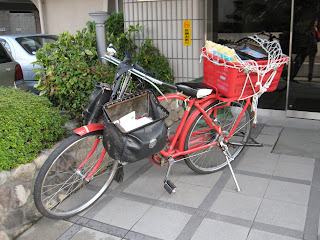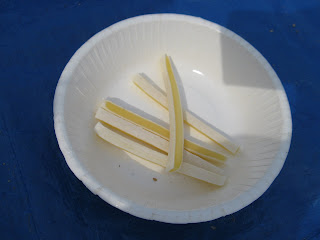When I told her about all the weddings, at first she was surprised. But then she pulled out her handy desk calendar and said, oh that Sunday was a very auspicious day (and of course a weekend), that's why there were so many weddings there! She went on to point out days that are good for pulling a person close to you (building a relationship). She said those days are also good for weddings, but not good for funerals. And of course there are inauspicious days too. I was a bit surprised to hear all this (didn't think the Japanese people were quite so superstitious), and very surprised to see these dates marked on a normal desk calendar.
For your entertainment, I offer the following photos.
This sign I see every day while waiting for the morning train. But I just noticed what it says: "Sauna and Radon". More radioactive water for people to soak in, I guess!
These rhinoceros beetles are really popular pets here. There is a lady at the bus stop who sells them from her bicycle! The beetles are huge - about the size of a person's hand! And they have these ferocious looking pinchers! Wikipedia has a bit more info about them.
Yesterday I went to the movies. It was only the second time I've gone since being here. Movies are very expensive, normally about $20. We were able to buy discount tickets, so we paid $14 to see 10,000 BC (there aren't many movie options in English. If we want to see a movie on a particular day, we have to ask which movie is playing in English and at what time, and that's what we see!). On Wednesdays, "ladies" pay only $10 to see a movie, so a few weeks ago, a few of us "ladies" saw Enchanted. I'm going to be very behind in movies when I get home! The movie theater is on the 7th floor of a building full of shops, and because of the height, the theater has these Slow Descending Devices at each window. Basically, a harness to lower yourself out the window in case of an emergency!! (You can click on the photos to zoom in and see the text. I love the sketch of the woman wearing a dress being lowered down the side of the building!)
On Friday night we had a going away party for Adam. The theme was Dagwood sandwiches. Everyone was instructed to bring such a sandwich - with a green olive on top! It was fun having a good excuse to splurge on nice bread (I am not impressed by Japanese bread - the crusts are soggy even on a loaf of French bread (they even think cream puffs are supposed to be soggy!)), sandwich fixings and green olives ($4 for a small jar of olives!).
It's almost time for Golden Week. This year it's split into two different weeks and two of those days fall on a weekend, so that's kind of a bummer. But it's not a good time to travel anyway, because EVERYONE in Japan is travelling then, and prices skyrocket. The holidays of Golden Week are April 29th (this Tuesday) - the Emperor's Birthday. May 3rd (next Saturday) - Constitution Memorial Day. May 4th (next Sunday) - Greenery Day (I'm not exactly sure what this is about). May 5th (next Monday) - Childrens Day. In Japan, only public holidays which fall on a Sunday are moved to the next day. Public holidays which fall on a Saturday are celebrated on that day since many people work a 6 day work week.
And one last thing - here's a very interesting blog devoted to Japanese convenience stores and the junk food one can buy there! http://www.konbini-life.com/ (Konbini means convenience store.)
Have a great weekend!




























































